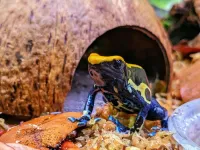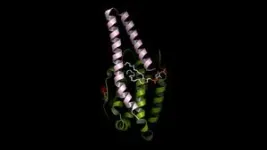(Press-News.org) The toe tapping behavior of various amphibians has long attracted attention from researchers and pet owners. Despite being widely documented, the underlying functional role is poorly understood. In a new paper, researchers demonstrate that Dyeing poison frogs modulate their taps based on specific stimuli.
Dyeing poison frogs, Dendrobates tinctorius, have been shown to tap their posterior toes in response to a range of prey sizes, from small fruit flies to large crickets. In the present study, the researchers hypothesized that if the tapping has a role in feeding, the frogs would adjust their behavior in response to different environmental cues.
To test their hypothesis, the researchers recorded the frogs under varying conditions. “I used the slow-motion camera on my iPhone to take minute-long videos of the frogs tapping. Afterwards, I went back to each video and counted the number of taps on each foot and how long they were visible since they were often hidden behind a leaf or the frog itself. I used those two numbers to get a "taps per minute" on each foot and added them up,” said Thomas Parrish, a former undergraduate student in the Fischer lab (GNDP), and the first author on the paper.
The researchers first tested whether the frogs tapped their toes more when they were feeding. To do so, the researchers fed the terrariums with half a teaspoon of fruit flies and recorded their hunting.
“We already knew the answer to this, but it was great to see that the tapping increased in the presence of the prey,” said Eva Fischer, an assistant professor of integrative biology. “We wanted to ask ‘Why?’ and we wondered whether it had a function in prey capture or it was just a excitatory response like how dogs wag their tails because they are excited.”
The researchers then used different surfaces to see whether the tapping behavior changed when the frogs could see the prey but not feed on it. They placed the fruit flies in small, clear Petri dishes in the frogs’ home and measured the rate of toe tapping. They found that the frogs had an average of 50 taps/minute when they couldn’t access the flies compared to 166 taps/minute when they fed on free-moving flies.
“The idea was that if they’re excited, we might see something different based on whether they can catch the flies,” Fisher said. “These results suggested that since they kept trying to eat in both cases, the tapping was not just out of excitement.”
The researchers wondered, then, whether the toe taps were a form of vibrational signaling where the frogs used it as a way to startle or distract the prey before they fed. They used four different surfaces to test this question: soil, leaf surfaces, gel, and glass.
“Soil and leaves are natural substances, but soil is not very responsive while leaves are. On the other hand, gels are responsive and glass is not, but they are both unnatural surfaces to frogs,” Fischer said.
They found that while the tap rate differed depending on the surface, with leaves being the highest at 255 taps/minute and glass the lowest at 64 taps/minute, there was no difference in the total number of feeding attempts or success.
“Although we saw that the frogs ate in every context, it was exciting to see that they changed their behavior based on what they're standing on,” Fischer said. “We were surprised, however, that we didn’t see a difference in how successful they were at eating. It’s possible that the experiment is like sending them to a buffet instead of what happens in the forest where the tapping may help in stirring the prey.”
The researchers are now hoping to understand what other stimuli might trigger this behavior. “Although we’ve conclusively shown that it is important in feeding, it could also be important in other contexts. For example, we have seen that the frogs tap more when there are other frogs nearby, so there may be a social aspect to it,” Fischer said.
They are also interested in studying the underlying biomechanical aspects of the muscles. “It would be cool to look at the anatomy and see how the muscles work,” Fischer said. “Ultimately, we could ask whether all frogs can tap their toes if they have the right muscles or whether there’s something special about the anatomy of poison frogs.”
The study “Tap dancing frogs: Posterior toe tapping and feeding in Dendrobates tinctorius” was published in Ethology and can be found at https://doi.org/10.1111/eth.13465. The work was funded by the Dr. Kirk and Mrs. Shannon Moberg Scholarship, Robert H. Davis Undergraduate Research Prize, the University of Illinois Urbana-Champaign, and the National Science Foundation.
END
Why do Dyeing poison frogs tap dance?
2024-05-28
ELSE PRESS RELEASES FROM THIS DATE:
UC Irvine study reveals circadian clock can be leveraged to enhance cancer immunotherapy
2024-05-28
Irvine, Calif., May 28, 2024 — A multidisciplinary research team at the University of California, Irvine has revealed that the circadian clock – the biological pacemaker that governs daily rhythms in physiological processes, including immune functions – can be leveraged to enhance the efficacy of checkpoint inhibitor cancer therapy. Checkpoint inhibitors block different proteins from binding to tumor cells, allowing the immune system’s T cells to kill the tumor.
The study, published online ...
Cell-targeting technology allows researchers to isolate neuronal subpopulations and link them to behavioral states
2024-05-28
(MEMPHIS, Tenn. – May 27, 2024) As gene sequencing technologies become more powerful, our understanding of cellular diversity has grown in parallel. This led scientists at St. Jude Children’s Research Hospital to create a tool to improve the ease and accuracy with which investigators can study specific subpopulations of cells. The tool, named Conditional Viral Expression by Ribozyme Guided Degradation (ConVERGD), allows researchers to specifically access these subgroups of cells and precisely manipulate ...
When should you neuter or spay your dog?
2024-05-28
Researchers at the University of California, Davis, have updated their guidelines on when to neuter 40 popular dog varieties by breed and sex. Their recent paper in Frontiers in Veterinary Science adds five breeds to a line of research that began in 2013 with a study that suggested that early neutering of golden retrievers puts them at increased risk of joint diseases and certain cancers.
That initial study set off a flurry of debate about the best age to neuter other popular breeds. Professors Lynette and Benjamin Hart of the School of Veterinary Medicine, the study’s lead authors, set out to add more breed studies by examining more than a decade ...
Is it a sound of music…or of speech? Scientists uncover how our brains try to tell the difference
2024-05-28
Music and speech are among the most frequent types of sounds we hear. But how do we identify what we think are differences between the two?
An international team of researchers mapped out this process through a series of experiments—yielding insights that offer a potential means to optimize therapeutic programs that use music to regain the ability to speak in addressing aphasia. This language disorder afflicts more than 1 in 300 Americans each year, including Wendy Williams and Bruce Willis.
“Although music and speech are different in many ways, ranging from pitch to timbre to sound texture, ...
New test rapidly diagnoses Toxoplasma infections and reduces false positives
2024-05-28
An inexpensive, accurate test that detects infections with the parasite Toxoplasma gondii can provide results within 30 minutes from a finger-prick in a doctor’s office or within an hour from a small blood sample tested in a local medical laboratory. The new test can also identify false positives in other types of commercial diagnostic tests for toxoplasmosis, providing swift reassurance to uninfected pregnant women and their doctors and facilitating timely interventions to protect a fetus against toxoplasmosis in acutely infected pregnant mothers.
These findings appear in a study, led by toxoplasmosis specialist Rima McLeod, MD, ...
Overlooked lipid connected to ancient cellular pathway with links to cancer
2024-05-28
Within the family of cell membrane lipids known as phosphoinositides and the kinase enzymes that regulate them, phosphoinositide 3-kinases (PI3Ks) have been cast in a starring role as scientists study their involvement in cancer, diabetes and many cellular activities.
The presence of PI3Ks in the scientific limelight has overshadowed other members of this lipid enzyme family, including phosphatidylinositol-5-phosphate 4-kinases (PI5P4Ks). Brooke Emerling, Ph.D., co-director of, and associate professor in, the Cancer Metabolism and Microenvironment Program at Sanford Burnham Prebys, is contributing to a revival of interest in this underappreciated set of enzymes.
Emerling and team have ...
Text reminders help connect health care workers to care and improve their mental health
2024-05-28
Health care workers have reported spikes in feeling burnt out in the time since the COVID-19 pandemic began, with nearly half saying it took a toll in 2022 compared to 32 percent in 2018. But a new study shows that easy-to-use and accessible platforms may help reverse this trend. Regular, automated text message reminders connecting staff to a mental health platform called “Cobalt,” drove significant improvements in both depression and anxiety scores among employees, according to a new JAMA Network Open study from the Perelman School of Medicine at the University of Pennsylvania.
“What we found shows ...
Optimal cancer-killing t cells discovered
2024-05-28
A team of cancer researchers, led by the University of Houston, has discovered a new subset of T cells that may improve the outcome for patients treated with T-cell therapies.
T cell-based immunotherapy has tremendous value to fight, and often eliminate, cancer. The strategy activates a patient’s immune system and engineers a patient’s own T cells to recognize, attack and kill cancer cells. In this way, the body’s own T cells become living drugs.
While T-cell immunotherapy has revolutionized cancer treatment, there is still much to learn. Unfortunately, not all patients ...
Wind farms are cheaper than you think – and could have prevented Fukushima, says global review
2024-05-28
Offshore wind could have prevented the Fukushima disaster, according to a review of wind energy led by the University of Surrey.
The researchers found that offshore turbines could have averted the 2011 nuclear disaster in Japan by keeping the cooling systems running and avoiding meltdown. The team also found that wind farms are not as vulnerable to earthquakes.
Suby Bhattacharya, Professor of Geomechanics at the University of Surrey’s Department of Civil and Environmental Engineering, said:
“Wind power gives us plentiful clean energy – now we know that it could also make other facilities safer and more reliable. The global review finds ...
Improved refrigeration could save nearly half of the 1.3 billion tons of food wasted each year globally
2024-05-28
May 28, 2024
Contact: Jim Erickson, 734-647-1842, ericksn@umich.edu
Graphic
Improved refrigeration could save nearly half of the 1.3 billion tons of food wasted each year globally
ANN ARBOR—About a third of the food produced globally each year goes to waste, while approximately 800 million people suffer from hunger, according to the U.N.'s Food and Agriculture Organization.
A new University of Michigan study concludes that nearly half of the food waste, about 620 million metric tons, could be eliminated by fully refrigerated food supply chains worldwide.
At the same time, ...





